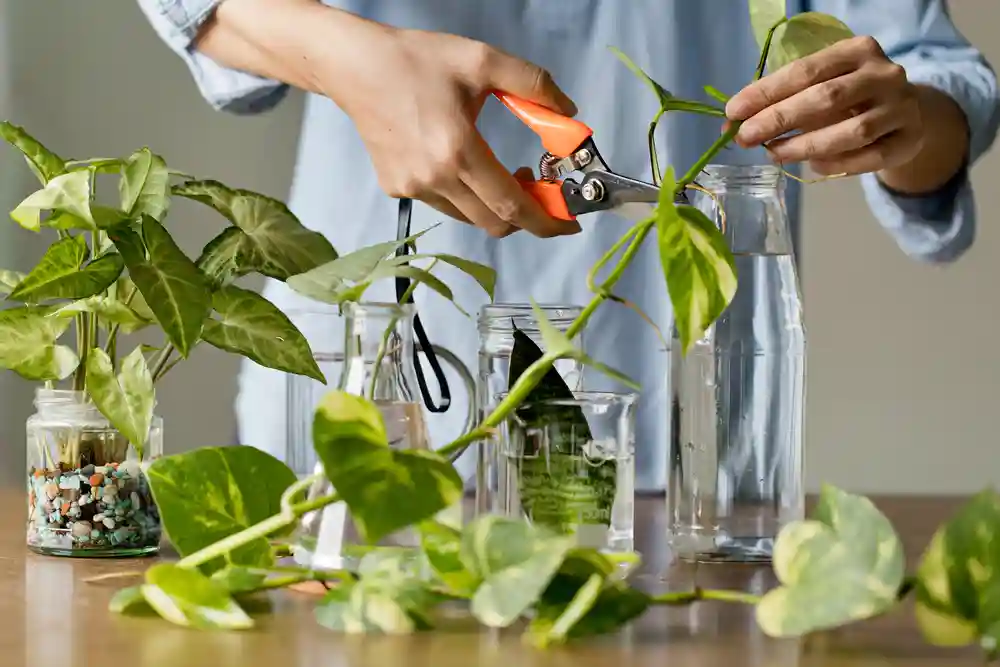Growing new plants from old ones is fun. You can make many plants without buying them. This saves money. It also gives you more plants for your garden.
Plant propagation means making new plants. You use parts of plants you already have. The new plants look just like the parent plant. This works because plants can grow from small pieces.
Most people think propagation is hard. But it’s not. You can start today with simple methods. Even kids can do it. You just need basic tools and patience.
Why You Should Learn How to Propagate Plants
Making your own plants has many good points. First, you save lots of money. Buying plants costs a lot. Making them costs almost nothing.
You can share plants with friends too. People love getting free plants. It makes them happy. You become known as the plant person in your area.
Some plants are hard to find in stores. When you know how to propagate plants, you can make rare ones. You can also keep plants that might die. Bad weather won’t destroy your whole collection.
- Save money on new plants
- Share with friends and family
- Keep rare plant types alive
- Make backup plants in case some die
- Fill your whole garden for cheap
- Start a small plant business
- Learn more about how plants work
Simple Tools You Need to Start
You don’t need fancy tools to learn how to propagate plants. Most things you already have at home. A few cheap items from the store will help a lot.
Sharp scissors work great for cutting. Clean them first. Dirty tools can make plants sick. A spray bottle helps water gently. Mason jars hold water for rooting.
Small pots work well for soil planting. You can use yogurt cups too. Just poke holes in the bottom. Regular potting soil works fine. Don’t use dirt from outside.
- Sharp, clean scissors
- Spray bottle for misting
- Glass jars or cups
- Small pots with holes
- Basic potting soil
- Plastic bags for humidity
- Labels to mark plants
- Rooting powder (helpful but not needed)
Water Method: The Easiest Way to Start
Water propagation is the best way to begin. You can see roots growing. It works fast for many plants. Kids love watching the roots appear.
Pick a healthy stem from your plant. Cut it about 4 inches long. The cut should be clean and straight. Remove leaves from the bottom part. These would rot in water.
Put the stem in a jar of water. Use clean water from the tap. Change the water every few days. Dirty water makes plants sick. Put the jar in bright light but not direct sun.
- Cut healthy stems 4-6 inches long
- Remove bottom leaves that touch water
- Use clean glass jars or bottles
- Change water every 3-4 days
- Place in bright, indirect light
- Wait 1-3 weeks for roots to show
- Plant when roots are 1-2 inches long
Best Plants for Water Method
Some plants love growing roots in water. These work great for beginners. They root fast and rarely fail.
Photos plants are super easy. Almost everyone has one. Just cut and stick in water. Roots show up in days. Mint from the kitchen works too. Cut fresh stems and put in water.
Other good choices include wandering Jew plants. These have purple and green leaves. Coleus plants with colorful leaves work well. Most houseplants with soft stems will try to root in water.
- Pothos (very easy)
- Mint and other herbs
- Wandering jew
- Coleus
- Philodendron
- Spider plant babies
- Tradescantia
- Begonia stems
Stem Cutting in Soil: More Plant Options
Soil cutting gives you more choices. Many plants won’t root in water but will in soil. This method works for outdoor plants too.
Cut your stem the same way as water method. Dip the cut end in rooting powder if you have it. This helps but isn’t required. Stick the stem in moist potting soil.
Cover with a plastic bag to keep humidity high. This stops the cutting from drying out. Check every few days. Spray with water if soil feels dry. New leaves mean roots are growing.
- Cut stems 4-6 inches long below a node
- Remove lower leaves
- Dip in rooting powder if available
- Plant in moist potting soil
- Cover with plastic bag
- Keep soil damp but not wet
- Look for new growth after 2-4 weeks
Plants That Like Soil Better
Many garden plants prefer soil over water. Roses can be grown from cuttings in soil. Lavender works well this way too. Most herbs like rosemary and sage prefer soil.
Woody plants need soil method. These have harder stems. Fruit tree branches can make new trees. Shrubs like azaleas work well in soil cutting method.
- Roses (all types)
- Lavender
- Rosemary and sage
- Azaleas and rhododendrons
- Fruit tree branches
- Boxwood and other shrubs
- Geraniums
- Chrysanthemums
Leaf Method: Amazing Magic Trick
Growing whole plants from single leaves seems impossible. But it really works. Succulents are best for this trick. Kids think it’s magic.
Pick a healthy leaf from a succulent. Pull it off gently. The whole leaf must come off clean. Let it sit for 2-3 days. This lets the cut end heal over.
Put leaves on top of cactus soil. Don’t bury them. Just lay them on the surface. Spray lightly with water every few days. Keep them in bright light but not hot sun.
- Choose plump, healthy leaves
- Pull off complete leaf with base
- Let dry for 2-3 days
- Place on top of cactus soil
- Spray lightly every few days
- Keep in bright, indirect light
- Baby plants appear in 2-6 weeks
Best Plants for Leaf Method
Most succulents work great for leaf propagation. Jade plants are very easy. Their thick leaves root fast. Echeveria makes pretty rosettes from leaves.
Sedum plants have small leaves that work well. African violets can grow from leaves too. Even snake plants can make new plants from leaf pieces.
- Jade plants
- Echeveria
- Sedum varieties
- Hen and chicks
- African violets
- Snake plant sections
- Begonia leaves
- Peperomia
Division: Split Big Plants Apart
Some plants grow in clumps. You can split these apart to make new plants. This is called division. It’s very easy and works fast.
Dig up the whole plant in spring or fall. Shake off the dirt so you can see the roots. Look for natural places where the plant separates. Pull or cut these apart gently.
Each piece needs roots and some green growth. Plant each piece like a new plant. Water well after planting. They usually grow right away since they already have roots.
- Dig up the whole plant
- Clean off dirt to see roots
- Find natural separation points
- Pull or cut apart gently
- Make sure each piece has roots
- Plant immediately in new spots
- Water well after planting
Plants Perfect for Division
Many garden plants form clumps over time. These work great for division. Hostas get bigger every year. You can split them into many plants.
Daylilies form large clumps too. Iris plants spread by underground stems. Ornamental grasses get huge and need dividing. Most perennial flowers can be divided.
- Hostas
- Daylilies
- Iris
- Ornamental grasses
- Astilbe
- Coral bells
- Bee balm
- Chrysanthemums
Air Layering: For Tough Plants
Some plants won’t root from cuttings. Air layering tricks them into making roots while still on the parent plant. This works for hard-to-root plants.
Pick a healthy branch on your plant. Make a small cut in the bark about halfway around. Wrap the cut with wet moss. Cover the moss with plastic wrap.
Tie the plastic tight above and below the moss. Keep the moss damp by adding water through the plastic. Roots will grow into the moss in a few months.
- Choose healthy, flexible branch
- Make shallow cut in bark
- Wrap cut area with wet moss
- Cover moss with plastic wrap
- Tie plastic tight on both ends
- Keep moss damp for several months
- Cut and plant when roots form
When to Use Air Layering
This method works for plants that are hard to root other ways. Rubber trees are perfect for air layering. Magnolia trees can be started this way too.
Fruit trees like citrus work well. Some houseplants with thick stems need this method. It takes longer but has a high success rate.
- Rubber trees and ficus
- Magnolia trees
- Citrus trees
- Rhododendrons
- Camellias
- Large houseplants
- Hibiscus
Seeds: The Natural Way
Growing from seeds is how plants do it in nature. Seeds cost very little. You can grow many plants from one seed packet. Some plants only grow from seeds.
Start seeds indoors for best results. Use seed starting soil in small pots. Plant seeds at the right depth. Small seeds need light soil cover. Big seeds can go deeper.
Keep soil moist but not soaking wet. Most seeds like warm conditions. A sunny window works well. Some seeds need cold treatment first. Read the seed packet for special needs.
- Use fresh, good quality seeds
- Start indoors for better control
- Plant at correct depth
- Keep soil consistently moist
- Provide warmth and light
- Thin seedlings if crowded
- Transplant when big enough
Easy Seeds for Beginners
Some seeds grow very easily. Beans and peas are foolproof. Kids can grow these with no help. Sunflowers are big and easy to handle.
Herbs like basil grow fast from seeds. Marigolds bloom quickly and attract bees. Lettuce grows in cool weather. Radishes are ready to eat in just weeks.
- Beans and peas
- Sunflowers
- Basil and other herbs
- Marigolds
- Lettuce and spinach
- Radishes
- Zinnias
- Nasturtiums
Common Problems and Easy Fixes
Even easy methods sometimes fail. Don’t give up. Most problems have simple solutions. Learning what went wrong helps you do better next time.
Cuttings that turn black and mushy got too much water. This is called rot. Use less water next time. Make sure pots have drain holes. Don’t water every day.
Cuttings that dry up and die need more humidity. Cover them with plastic bags. Spray them more often. Move them away from hot, dry air.
- Black, mushy stems = too much water
- Dried up cuttings = need more humidity
- No roots after 6 weeks = try different method
- Leaves falling off = normal stress response
- Slow growth = needs more light or warmth
- White fuzzy growth = fungus from poor air flow
How to Prevent Most Problems
Clean tools stop disease spread. Wipe scissors with rubbing alcohol between plants. Use fresh potting soil, not old dirt. Don’t crowd plants together.
Watch your plants daily. Catch problems early. Remove any dead or sick parts right away. Good air flow prevents most fungus problems.
- Clean tools between plants
- Use fresh potting soil
- Give plants space for air flow
- Check plants daily
- Remove dead parts quickly
- Don’t overwater
- Provide adequate light
Best Times to Propagate Different Plants
Timing matters when you want to know how to propagate plants well. Spring is great for most methods. Plants are starting to grow actively. They root faster in warm weather.
Fall works well for dividing perennials. The weather is cooler so plants don’t stress as much. Winter is good for indoor water propagation. Summer heat can be too much for delicate cuttings.
Different plants have different best times. Learn when your favorite plants like to be propagated. Keep notes about what works best.
- Spring: best for most stem cuttings
- Early summer: good for softwood cuttings
- Late summer: semi-hardwood cuttings
- Fall: divide perennials, collect seeds
- Winter: indoor propagation, plan for spring
- Year-round: houseplant propagation indoors
Setting Up Your Propagation Space
You need a good spot to work on plant propagation. A table near a window works great. You need good light but not hot sun. A spare bedroom or basement can work too.
Keep your supplies organized in one place. This makes the work go faster. Label everything so you remember what plants you’re growing. Take pictures to track progress.
Clean your space regularly. Remove dead leaves and change old water. Pests like messy areas. A clean space grows healthier plants.
- Choose spot with bright, indirect light
- Keep supplies organized and handy
- Label all plants with names and dates
- Take photos to track progress
- Clean up regularly
- Provide good air circulation
- Maintain steady temperature
Making Money from Plant Propagation
Once you learn how to propagate plants well, you might want to sell some. People love buying homegrown plants. You can start small and grow bigger over time.
Farmers markets are great places to sell. People there like supporting local growers. Online sales work well too. Social media helps spread the word about your plants.
Start with easy plants that people want. Herbs sell well because people cook with them. Houseplants are popular year-round. Seasonal flowers sell at the right times.
- Start at farmers markets
- Use social media to advertise
- Focus on popular, easy plants
- Herbs and houseplants sell well
- Offer rare varieties people can’t find
- Price fairly but cover your costs
- Build repeat customers
CONCLUSION:
Learning how to propagate plants transforms your gardening experience completely. You save money while filling your home with beautiful plants. Start with simple water propagation using plants you already own. Practice makes you better at every method. Soon you’ll have endless plants to share with friends and family. You might even start selling them for extra income. Plants naturally want to grow and multiply – you’re simply helping this process. With patience and basic care, anyone can master plant propagation successfully.






